Russian air strikes kill 26 in devastating attack on Ukraines Ternopil – Al Jazeera English
Published on: 2025-11-20
AI-powered OSINT brief from verified open sources. Automated NLP signal extraction with human verification. See our Methodology and Why WorldWideWatchers.
Intelligence Report:
1. BLUF (Bottom Line Up Front)
The most supported hypothesis is that the Russian airstrike on Ternopil was a strategic move to target Ukraine’s critical infrastructure and disrupt its energy and transportation capabilities. This aligns with Russia’s broader military objectives in Ukraine. Confidence level: Moderate. Recommended action: Enhance defensive measures for critical infrastructure and strengthen diplomatic efforts to address potential escalations.
2. Competing Hypotheses
Hypothesis 1: The Russian airstrike on Ternopil was primarily aimed at degrading Ukraine’s energy and transportation infrastructure to weaken its military and economic resilience.
Hypothesis 2: The airstrike was a retaliatory action in response to alleged Ukrainian attacks on Russian territory, intended to deter further Ukrainian military actions.
Hypothesis 1 is more likely given the pattern of Russian attacks on infrastructure and the strategic importance of such targets in undermining Ukraine’s warfighting capabilities. Hypothesis 2, while plausible, lacks corroborative evidence of a direct link between the alleged Ukrainian attacks and the timing of the Ternopil strike.
3. Key Assumptions and Red Flags
Assumptions: It is assumed that Russia’s primary military objective remains the destabilization of Ukraine’s infrastructure. The information provided by Ukrainian officials is assumed to be accurate.
Red Flags: The potential for misinformation or propaganda from both Russian and Ukrainian sources. The timing of the strike coinciding with President Zelenskyy’s diplomatic visit could suggest a strategic message or misdirection.
4. Implications and Strategic Risks
The attack on Ternopil could lead to increased civilian casualties and displacement, further straining Ukraine’s humanitarian resources. Politically, it may harden Ukraine’s stance in peace negotiations and increase international support for Ukraine. Economically, continued infrastructure attacks could severely impact Ukraine’s energy supply, leading to broader regional instability. There is also a risk of escalation if Ukraine retaliates with significant force, potentially drawing in NATO allies.
5. Recommendations and Outlook
- Enhance air defense systems around critical infrastructure to mitigate future attacks.
- Strengthen diplomatic channels to de-escalate tensions and seek international mediation.
- Best-case scenario: Successful diplomatic intervention leads to a ceasefire and negotiations.
- Worst-case scenario: Escalation leads to broader conflict involving NATO forces.
- Most-likely scenario: Continued sporadic attacks with ongoing diplomatic stalemate.
6. Key Individuals and Entities
Volodymyr Zelenskyy, Ihor Klymenko, Oksana Kobel.
7. Thematic Tags
Regional Focus, Regional Focus: Ukraine, Russia, NATO, Energy Infrastructure, Military Strategy
Structured Analytic Techniques Applied
- Causal Layered Analysis (CLA): Analyze events across surface happenings, systems, worldviews, and myths.
- Cross-Impact Simulation: Model ripple effects across neighboring states, conflicts, or economic dependencies.
- Scenario Generation: Explore divergent futures under varying assumptions to identify plausible paths.
Explore more:
Regional Focus Briefs ·
Daily Summary ·
Support us





